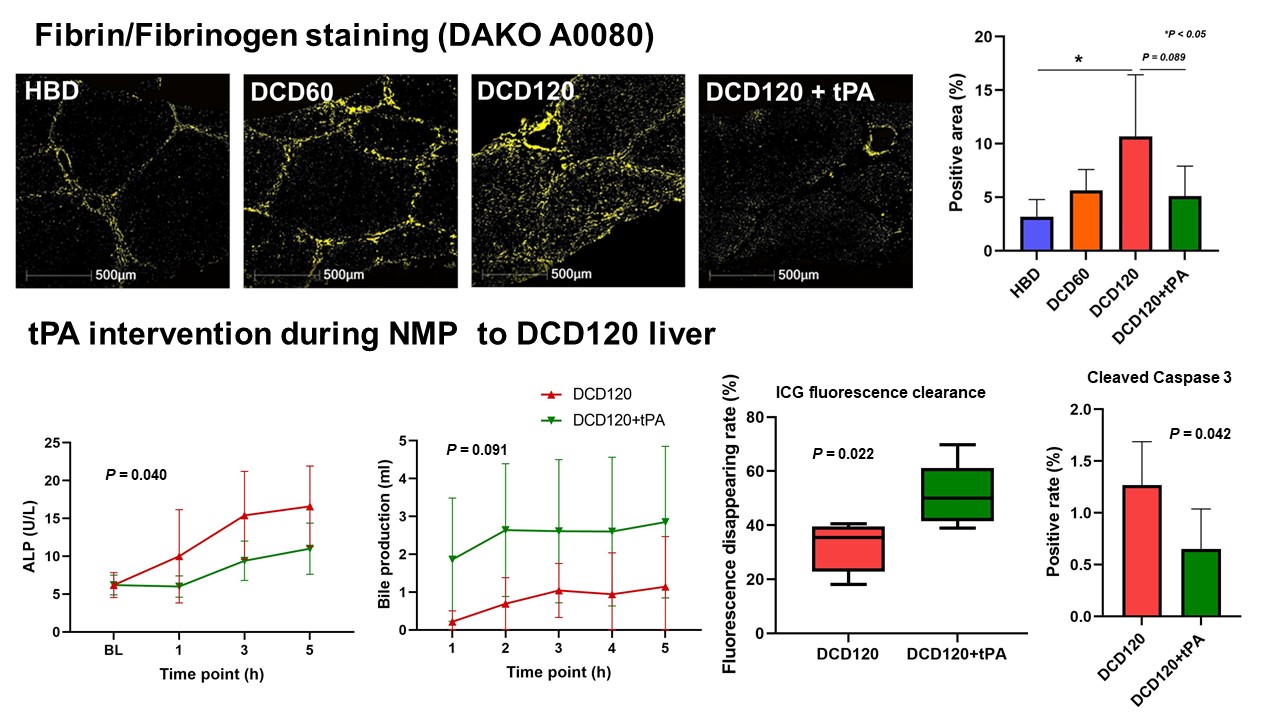Fibrin Deposition in Ischemic Damaged Liver Grafts and Reconditioning with Thrombolytic Therapy During Normothermic Machine Perfusion
Ajmera Transplant Program, Department of Surgery, Toronto General Hospital, University Health Network, Toronto, ON, Canada
Meeting: 2022 American Transplant Congress
Abstract number: 942
Keywords: Donors, marginal, Liver transplantation, Machine preservation, Pig
Topic: Basic Science » Basic Science » 15 - Machine Perfusion and Organ Rehabililtation - Basic
Session Information
Session Name: Machine Perfusion and Organ Rehabilitation - Basic
Session Type: Poster Abstract
Date: Sunday, June 5, 2022
Session Time: 7:00pm-8:00pm
 Presentation Time: 7:00pm-8:00pm
Presentation Time: 7:00pm-8:00pm
Location: Hynes Halls C & D
*Purpose: Normothermic ex situ perfusion (NMP) is a novel technique for the storage and assessment of marginal livers retrieved from donors after circulatory death (DCD). Micro-thrombosis is considered as one of the causes inducing poor liver function and ischemic cholangiopathy, but the correlation between micro-thrombosis and degrees of warm ischemia is still unknown. In this study, fibrin depositions within porcine livers were assessed during NMP following various times of warm ischemia. The efficacy of thrombolytic therapy with tPA during NMP was investigated.
*Methods: 29 to 35 kg male Yorkshire pigs were allocated to 4 groups; Heart beating donor (HBD), DCD 60 minutes, DCD 120 minutes and DCD 120 minutes + tPA (tissue plasminogen activator), each N=5. Following induction of warm ischemia with heparinization, procurement and 2.5-hour cold storage, the livers were perfused with washed-erythrocyte-based NMP for 5 hours. In the DCD120-tPA group, tPA was administrated twice from the hepatic artery at 5 mg/kg (graft weight) each, one during the back table flush and the other immediately after the start of NMP. Fibrin/Fibrinogen deposition was assessed at the end of perfusion by needle biopsy with DAKO A0080 staining.
*Results: The fibrin/fibrinogen deposition within the liver parenchyma increased with longer warm ischemic time (HBD 3.2% vs DCD60 5.6% vs DCD120 10.7%, P = 0.021). tPA administration during NMP reduced fibrin in DCD120 livers similar to the DCD60’s level (5.1% vs 5.6%). Hepatic artery and portal venous flow, AST, and lactate were similar between tPA treated and untreated livers during NMP. The tPA treated livers had lower ALP levels (P = 0.040), increased bile production (P = 0.091), and ICG clearance (51.0% vs 32.1%, P = 0.022) during perfusion. Cleaved caspase 3 positive hepatoytes were decreased with tPA treatment (0.65% vs 1.27%, P = 0.042).
*Conclusions: Fibrin depositions increase in DCD porcine grafts with prolonged warm ischemia times. tPA reduces fibrin in the liver and improves markers of bile duct injury and function.
To cite this abstract in AMA style:
Goto T, Noguchi Y, Ganesh S, Arulratnam B, Kawamura M, Parmentier C, Ray S, Reichman T, Selzner N, Selzner M. Fibrin Deposition in Ischemic Damaged Liver Grafts and Reconditioning with Thrombolytic Therapy During Normothermic Machine Perfusion [abstract]. Am J Transplant. 2022; 22 (suppl 3). https://atcmeetingabstracts.com/abstract/fibrin-deposition-in-ischemic-damaged-liver-grafts-and-reconditioning-with-thrombolytic-therapy-during-normothermic-machine-perfusion/. Accessed December 13, 2025.« Back to 2022 American Transplant Congress

